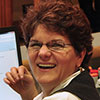This article is more than 5 years old.
Yesterday at noon, Roz, Susan and I attended the meeting held at DeTamble Hall in Tribble about the coming online Master’s program created by Counseling and developed and managed with the help of Embanet. The program will launch in Summer, 2012. Jennifer Collins related that, while the institution does have the best teaching faculty, they don’t have the wherewithal to transfer their teaching to an online environment. So they worked with Embanet to develop programs that will have the same course goals, the same high standards, the same evaluative requirements, the same tuition, and the same admission requirements as their face to face equivalent. It was further related that the face to face program is so competitive that they have hundreds of applicants that they narrow down to 80 to 90 that are all equally qualified to fill only 15 slots. They also recognized that not everyone can uproot their lives mid-career to come to live in Winston-Salem to complete this rigorous program in 2 years. So the online program was developed to meet a number of obvious needs.
Embanet discussed their process. They pair an instructor of a course with an instructional designer who has expertise in the best online practices. They have intensive discussions on the ultimate goals of the course, and clarify both pedagogy and the best tools to utilize. The framework is built around course objectives, with customized educational approaches. The focus is to keep students engaged and communicating with each other and with the instructor. They demonstrated a number of learning tools routinely incorporated into these classes that provide similar modules with increasingly complex ideas, synchronous and asynchronous tools, discussion boards, chat, Webex, Google Talk, instructor and student blogs and more. They showed an example of a program called Voicethread which enables distance ed presenting. Voicethread provides space for students to upload their presentation slides and audio, while giving the other students and faculty an opportunity to insert comments or questions as the presentation is given.
The rigor of the courses will be the same. Evaluation of course effectiveness will be ongoing with a systematic course refresh happening after every 3rd time the course is presented. Like face-to-face classes, the more faculty are “engaged” in the course the more students will get out of it. Ultimately, the program will have a maximum of 300 students, and the course work will be structured to enable students to complete the program in 3 years. As the q & a of the session progressed, faculty in the room seemed to be more and more comfortable with the idea. And I, personally, was quite impressed!

2 Comments on ‘Embanet and Counseling’
Thanks for this- I wasn’t able to attend, but was very interested in this venture. Terrific write up.
Thanks for the good summary, Mary Beth!